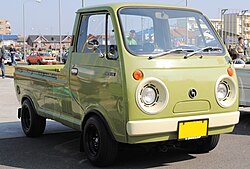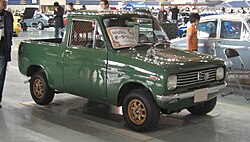Mazda Porter
| Mazda Porter | |
|---|---|
| Manufacturer: | Mazda |
| Production period: | 1968-1989 |
| Previous model: | Mazda B360 |
| Successor: | Mazda Scrum |
The Mazda Porter was a pickup truck in the Japanese kei car class that Mazda presented in 1968 as the successor to the Mazda B360 . While the Porter, like the previous model, was offered as a pickup or station wagon and panel van , the Porter Cab was only available as a small flatbed truck . With the discontinuation of the Porter in 1976, the model series consisted only of the Porter Cab. In 1989, the Mazda Scrum was the successor.
Mazda Porter 1968-1976
| porter | |
|---|---|
| Production period: | 1968-1976 |
| Body versions : | Flatbed trucks , panel vans , minibuses |
| Engines: |
Otto engine : 0.36 liters |
| Length: | |
| Width: | |
| Height: | |
| Wheelbase : | 1995 mm |
| Empty weight : | 475 kg |
The Porter (E360 in the export markets) was produced from November 1968 to April 1976 either as a pickup (KBDB33) or station wagon / panel van (KBDBV). It was based on the chassis of the predecessor Mazda B360 , but had a completely new body and interior. Initially he had the 358 cc four-stroke engine with 20 hp (15 kW) of the B360. From April 1973 the water-cooled 359 cc two-stroke two-cylinder from the Mazda Chantez with 35 PS (26 kW) was installed, with some cosmetic changes to the KBAA / KBAAV series. In 1975 the Porter was modified again to be able to carry new, larger number plates, as previously kei-car cars had smaller number plates than normal cars. The engine's output was reduced to 32 HP (24 kW) in order to comply with new, stricter emissions regulations. The porter had a payload of 300 kg on the pickup and offered 5 seats as a station wagon. In 1976 the model series was discontinued without a successor.
Porter Cab 1969-1989
| Porter Cab | |
|---|---|

|
|
| Production period: | 1969-1989 |
| Designs: | Pickup truck |
| Engines: |
Petrol engines : 0.36–0.55 liters |
| Length: | 2995-3195 mm |
| Width: | 1295-1395 mm |
| Wheelbase: | 1835 mm |
The small truck Porter Cab (KECA53) was introduced in March 1969. The flatbed truck was based on the Porter, but had a shorter wheelbase of 1835 mm. He had a 359 cm³ water-cooled two-stroke two-cylinder with 23 HP (17 kW) at 5500 revolutions per minute. This engine (CC) was Mazda's first two-stroke engine. The top speed was 90 km / h (56 mph). The Porter Cab was only available in the body colors yellow and light green. As early as 1970 the arrangement of the windows in the front doors was changed from sliding windows to lifting windows and a radiator grille for ventilation was integrated on the front. Like the Porter, the Porter Cab received the Chantez engine in April 1973, but with 30 hp (22 kW) at 6000 revolutions per minute. In January 1975, the Porter Cab was slightly modified to accommodate the new larger license plates. With its peculiar panels around the headlights, the Porter Cab had a high recognition and sympathy value and was therefore very popular in its class. It was marketed in the export markets as the Porter Cab E360.
1977 saw the market launch of the revised New Porter Cab. The length increased by 200 mm, almost exclusively behind the rear axle, the width by 100 mm, while the wheelbase remained the same. Due to the changed emissions regulations in the kei car class in 1976, Mazda decided due to the shrinking sales in this category that it was not a worthwhile expense to develop a new, appropriately clean 550 cc engine. Instead, Mitsubishi bought the 2G23 Vulcan engine and from now on equipped the Porter Cab with it, while production of the Porter and Chantez was discontinued.
The Vulcan 2G23 546 cc two-cylinder engine from the Mitsubishi Minicab developed 31 hp (23 kW) at 5500 revolutions per minute in the Porter Cab. The headlight covers were cut off and now made square. The Porter Cab II was only available in light blue with light gray bumpers and headlight covers and a black interior. In 1983 there was a facelift with the now white body and dark gray add-on parts and brown interior as well as the Vulcan II engine with reduced exhaust emissions with the same output. In 1985 there was another slight facelift, with now black trim and a black band between the headlights, while the interior was now gray. Instead of a toothed belt, the engine now had a timing chain. Air conditioning was now available as an option, among others . Although the Mitsubishi Minicab got new three-cylinder engines in 1987, the Porter Cab was still available with the old two-cylinder, since the end of the series had already been decided. So in June 1989 Mazda stopped production of the Porter Cab after twenty years of continuous production with nothing more than facelifts. The model was replaced by the Autozam Scrum , which is based on the Suzuki Carry , and offers this by means of badge engineering in the home market as Mazda Scrum on.

